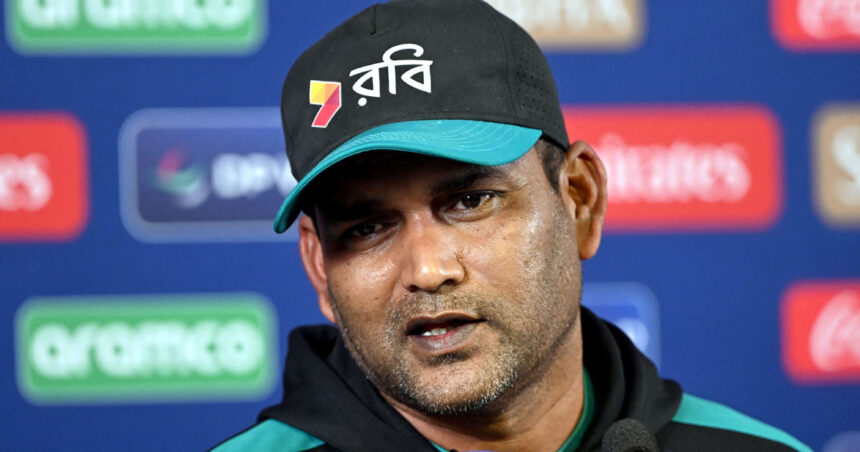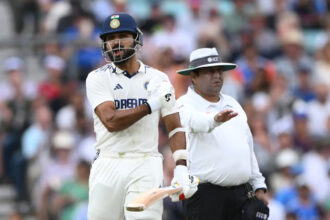Senior assistant coach Mohammad Salahuddin has sent a strong message regarding the national team’s batting order. Emphasizing the importance of team over individual preference, Salahuddin said, “You have to fulfill whatever role you’re given for the sake of the team. If you don’t like it, there’s no need to play.”
With the national team’s batting lineup still under discussion, Salahuddin made it clear that even openers must be ready to bat lower down the order if needed. Otherwise, he believes, there’s no place for such players in the national squad.
Bangladesh announced a 16-member squad for the upcoming tours of the UAE and Pakistan, which includes four designated openers—Liton Das, Soumya Sarkar, Parvez Hossain Emon, and Tanzid Hasan. If Nazmul Hossain Shanto is also considered, the number of potential openers rises to five.
Among them, Soumya, Parvez, and Tanzid usually open in all formats, while Liton has mostly played as an opener in T20Is. Though Shanto is a bit of an exception, he too has opened frequently in domestic T20s.
Before Sunday’s training session in Mirpur, Salahuddin addressed questions in a press conference about whether all five were being considered solely for the opening role. His response was direct and unambiguous.
“Where someone has batted before isn’t important. If the team feels you need to bat at number seven, even as an opener, you must do it. You have to do what’s best for the team.”
He further stressed the team-first mentality that the coaching staff is trying to instill.
“We’re trying to build a culture. This team doesn’t belong to any individual—it’s the property of the nation. Whatever responsibility you’re given, even if you don’t enjoy it, you have to perform it. If you can’t accept that, then there’s no need to be in the team. We’ll decide tactically before matches who will play when.”
Former technical consultant Sridharan Sriram also emphasized this flexible approach during his time with the team, even using Mehidy Hasan Miraz as a makeshift opener in some matches. However, the reverse—sending regular openers down the order—has been a rare move.
Chief selector Gazi Ashraf Hossain recently stated that Liton might be tried at number three in the upcoming seven matches, while hinting at using the out-of-form Shanto as a backup.
The upcoming UAE series marks the start of Bangladesh’s T20 World Cup preparation, but the team’s overall standing in this format is far from impressive. Even in ODIs, once considered a safe haven, Bangladesh has fallen behind—dropping to tenth in the ICC rankings. They also recently lost a home Test to Zimbabwe.
Salahuddin acknowledged these concerns and called for broad structural changes.
“This is a long-term process. It’s not only about the national team. We must look at how well our structures are developing—players in the A team, HP unit, and Tigers program. Are we building the right culture? The national players are giving their best and want to improve.”
“But a country’s cricket can’t rely on just a handful of players. We need a strong system from the grassroots. Everyone must work together. All departments must function in sync for national cricket to move forward.”
The experienced coach also stressed the need for proper planning and execution.
“It doesn’t depend on one player. This is a collective effort. Four departments—Game Development, HP, Tigers, and the national team—must align their goals. Good planning must be followed by good execution, or we’ll keep standing in the same place.”
The conversation also turned to Bangladesh A’s recent series against New Zealand A, where top-order batters failed to score big despite dominating in domestic cricket. Enamul Haque, Mohammad Naim, and Parvez Hossain were the top run-scorers in the Dhaka Premier League but struggled at the A level.
Salahuddin pointed to a longstanding issue behind this disparity.
“There’s a big gap between domestic and international cricket. We’re failing to bridge that gap, and that’s our fault. In Dhaka League, players often face left-arm spin by the second over. But in international cricket, they have to handle 140 km/h pace bowling daily.”
“This isn’t necessarily the players’ failure. Maybe we haven’t given them the right opportunity to develop. If someone performs in domestic cricket, it means they have something. When they come to the national level, we need to test them at that standard before bringing them in.”






